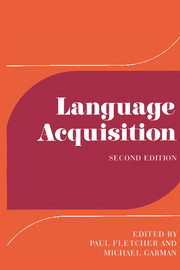Book contents
- Frontmatter
- Contents
- Contributors
- Preface
- Part I Contexts and determinants
- Part II The development of linguistic systems: phonology
- Part III The development of linguistic systems: grammar
- Introduction
- 13 Early vocabulary
- 14 Early syntax
- 15 Assessing morphological development
- 16 Personal pronouns
- 17 Tense and aspect
- 18 Modality
- 19 Deixis
- 20 A crosslinguistic perspective: morphology and syntax
- Part IV Later language development
- Notes to chapters
- Bibliography and citation index
- General index
- Titles in the series
13 - Early vocabulary
Published online by Cambridge University Press: 05 June 2012
- Frontmatter
- Contents
- Contributors
- Preface
- Part I Contexts and determinants
- Part II The development of linguistic systems: phonology
- Part III The development of linguistic systems: grammar
- Introduction
- 13 Early vocabulary
- 14 Early syntax
- 15 Assessing morphological development
- 16 Personal pronouns
- 17 Tense and aspect
- 18 Modality
- 19 Deixis
- 20 A crosslinguistic perspective: morphology and syntax
- Part IV Later language development
- Notes to chapters
- Bibliography and citation index
- General index
- Titles in the series
Summary
Introduction
Before children put together their first two-word sentences, at very approximately 18 months of age, their language acquisition appears, in terms of what strikes the investigator's ear, to consist mainly in amassing a stock of words. The period from the child's first ‘word’, at very approximately 9 months, to the first sentences is then a conveniently delimited one for an essay on early vocabulary.
A child of 18 months has accumulated a vocabulary of ‘words’ attested in production that numbers about 45. This figure is derived from Benedict's (1979) quantitative study of eight children. The 18 children in Nelson's (1973b) monograph would give a slightly lower average at 18 months; the average for the six children studied by Rescorla (1980) is higher. The inventory for comprehension begins earlier and increases more rapidly (see e.g. Valentine 1942: 400; Leopold 1949b: 162–7; Snyder, Bates and Bretherton 1981). An impression of how many ‘words’ are understood at age 18 months may be gleaned from the fact that Benedict's (1979) sample reached cumulative comprehension totals of 50 at a mean age of 1;1.5; had up to that point been gaining, on average, 22 ‘words’ a month; and were at that point still all evincing upward trends. Twenty-two new expressions a month would, if the same rate were continued for another 5 months, add 110 items, to give a total of about 160 by 18 months.
- Type
- Chapter
- Information
- Language AcquisitionStudies in First Language Development, pp. 279 - 306Publisher: Cambridge University PressPrint publication year: 1986
- 5
- Cited by



